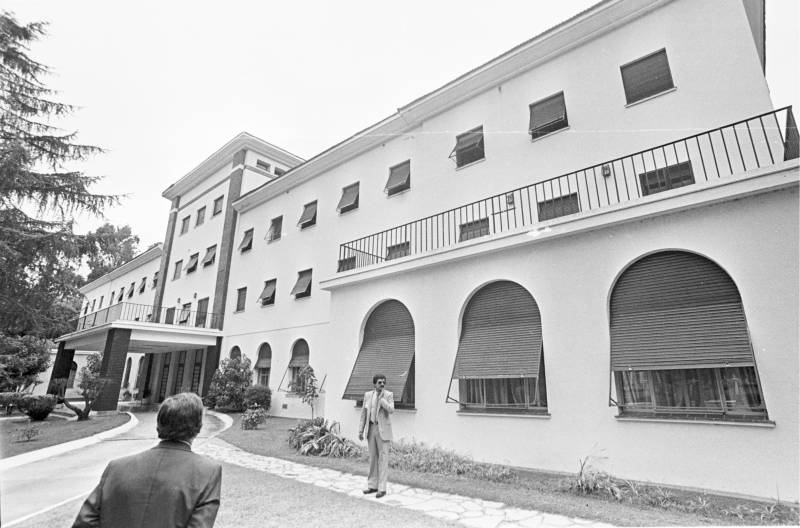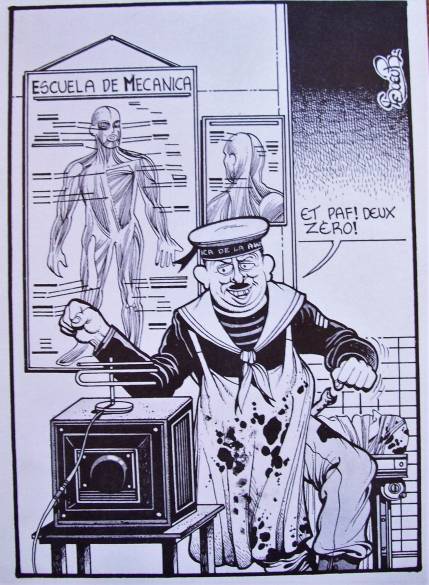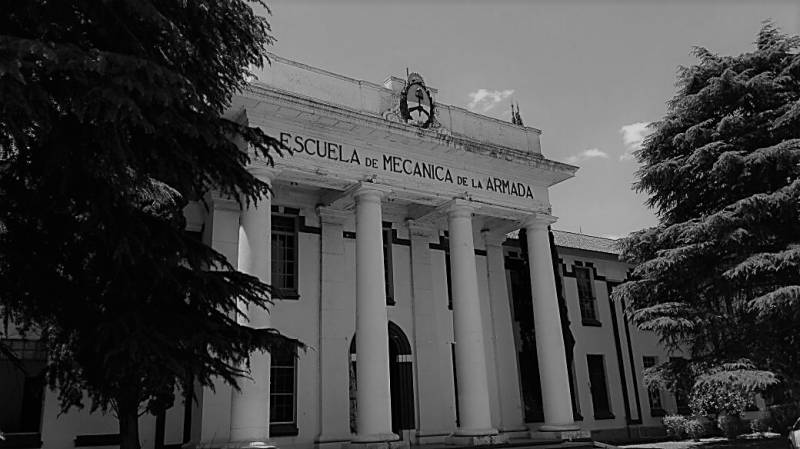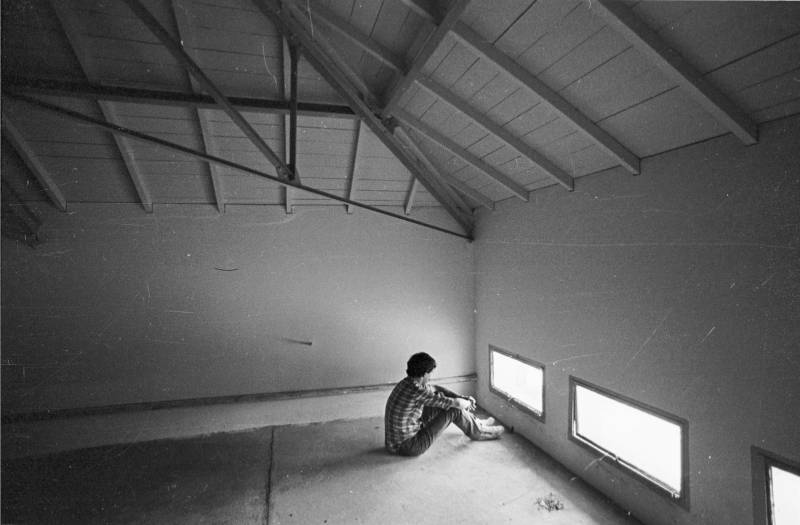“El Tigre”, Jorge Eduardo Acosta, came screaming “We won, we won!”.
“If they won, we lost,” I thought.
We were all prisoners. For days, weeks, months, years, the task force had been kidnapped people and keeping them captives in the Officers’ Club of the ESMA for varying amounts of time.
 Foto tomada por la Conadep en 1984 (Memoria Abierta).
Foto tomada por la Conadep en 1984 (Memoria Abierta).
“We have all the time in the world,” they said. And so they did. In June 1978, they had time and power. Power to kill you and power not to kill you, to let you live. Power to kill you in the torture room, the next day, the next month, power to include you in the next list of “transfers”. Power to let you live for few days, sometimes years. Power to take a few of us to the world that was on the other side of the bars of the ESMA. This power included another power: to select among the captives in the clandestine center some –few, very few– to begin the “recovery process” and use them as slave labor. Meanwhile, the majority remained silent, immobile, shackled, handcuffed and hooded in “Capucha”, “Capuchita”, we were hooded even in the basement. In that basement, in “El Dorado”, in “Pecera”, the “selected” had to perform the tasks that they assigned: typing, fixing defects, reading and summarizing news articles, falsifying documents. We read newspapers and magazines, we talked to each other, and we could watch television at authorized times.
I slept hooded and did slave work in the basement, or as we called it, “Pecera” (fishbowl). We talked about the ‘78 World Cup. We knew the dates. We knew about some organizations abroad, and even some of the national teams had discussed whether or not to boycott the World Cup. It was a controversial issue: the opposition to the boycott was based on the fact that football was a popular passion that was impossible to ignore. They believed that boycotting would provoke rejection from the people and that they would not understand the true reasons for the boycott. Those in favor argued that it was necessary to prevent the dictatorship from taking advantage of the Championship in order to project a false positive notion. It was a similar situation to what happened when talking about the Olympics during Nazism.
 Afiche por el boicot al Mundial hecho en Francia (El Topo Blindado).
Afiche por el boicot al Mundial hecho en Francia (El Topo Blindado).
In the foreign press we could see signs of these discussions. For example, they discussed the situation of the country where the World Cup would be played; there were press releases that ended with the slogan, “Argentina Champion, Videla to the wall”. Montoneros decided not to boycott to take advantage of those days to extend the denunciation campaigns. As i learned later they made a kind of “protocol” with the scope and restrictions of armed actions that they were going to carry out.
However, in addition to the dilemma mentioned above, the ‘78 World Cup multiplied the dangers. The militancy that remained hidden, like the human rights organizations, was going to take advantage of the amount of foreign journalists who would arrive, to denounce before them the crimes of the dictatorship so that the siege of silence could be broken from within Argentina itself. The military knew that and would take this opportunity to continue the hunting. Colleagues from the exile were also going to return to participate in operations and in denunciating campaigns.
We, the prisoners, didn´t talk about this, the warning about what to say to whom was permanent. But it surely was a fear we all have: that the vulnerability of the comrades who were outside would become even greater. Also, I'm sure they liked football, maybe they even planned to leaflet pamphlets during a game... The repressors knew that; for them any event where people would gather, a circus, a match, could provide potential "targets".
The kidnapped also talked about football, about the players, about César Luis Menotti, even in that underground world, disappeared from the outside. About Menotti the disquisitions were very long: if it was true that he was close to the Communist Party; that he had a conception of football more as a group sport, not of individuals. Paradoxically the military had banned group theory (that studies the algebraic structures known as groups) because "forming groups" was a threat to the Christian West... I didn´t open my mouth, I had no idea what Menotti's strategy was, nor could I understand –I still don´t– which tactics should be used: "4-3- 3 4-4-2", or something like that. People would talk about that for hours.
The days of the match marked, in some way, the rhythm of what happened in the concentration camp. The task force intensified its criminal activity: the damn "rides" multiplied. “Rides”: they went out in a car taking some prisoner with them so he could “point at” comrades they might come across. They waited for hours at bus stations, hydrofoil stations, airports, train stations... a task group and their captive in alert. They came back almost always empty-handed those days. It was then that they took me out for the first time: in the metal box of a truck that they called "Swat", with a stretcher bolted to the floor, prepared to torture right there. The Swat circulated throughout the city, “fishing”. It returned as it left: with a single captive, me. Another time they took me to a bar that was in Paraná and Sarmiento. Opposite, in the San Martin Cultural Center, the press met, and those in the task force thought that some militant could come to talk with foreign journalists.

One day, several kidnapped people were talking in the back room of the “Pecera” and there was a noise. Someone said “thunder”. "What thunder?” –said Pelado Jaime– "that was a rocket." He was right, Montoneros had fired on the "Four Columns" building, and it is said it hit right there where "School of Navy Mechanics" is written.
We saw the matches on a black and white television that was in the last office, to the right of the “Pecera”. I can´t say what was going on inside the thoughts of each of us, but in those hours it was as if we entered a kind of bubble.
–Go ahead!
–Beto Alonso ...
–But Kempes...
–Luque.
–Ardiles.
–Go ahead, go ahead, César Luis!– when they focused on Menotti.
Lieutenant Juan Carlos Rolón, alias “Niño” was the officer in charge of the “Pecera”. He was a football fan; he discussed about “Beto” Alonso with his prisoners for hours.
To the disappeared who were twenty-four hours imprisoned with hoods the World Cup was the shouting from River stadium when there was a match there. So close but light years away from the ESMA.
On the day of the final, even I immersed myself in the logic of the bubble. When the game ended, great excitement... Acosta entered euphoric, and shouting "we won, we won". He gave the men a hand and the women a kiss.
The truth was hard to take: "If they won, we lost."
After a while, a soldier told several of us “get ready to leave”. They put me on a green Peugeot 504 with prefect Héctor Febres, alias "Selva", and Petty Officer Mendoza. The car took Cabildo Av. and headed downtown. I couldn´t believe such a crowd screaming, jumping happily. I was suffocating. I asked Febres for permission to peer through the sunroof “to watch how they celebrate” I stood up and watch. “If I start screaming that I'm a disappeared nobody will give a crap”, I thought as I cried.
 Foto tomada por la Conadep en 1984 (Memoria Abierta).
Foto tomada por la Conadep en 1984 (Memoria Abierta).
There were so many cars, we couldn´t move forward, so they turned around and headed for Martinez, to a grill on Maipú Av. There, at the same table, torturers and tortured. Again the suffocation. I asked permission to go to the bathroom. Inside, with the door firmly closed, I began to write with a lipstick on the tiles: "Milicos murderers, Massera assassin, long live to Montoneros”. I went back to the table. I became a prisoner again, and I wanted to go back to “Capucha”. I knew more about the horrible logic of that underground world than what I was seeing outside.
That was solitude: knowing that, if I shouted that I was a disappeared, no one was going to give a crap.